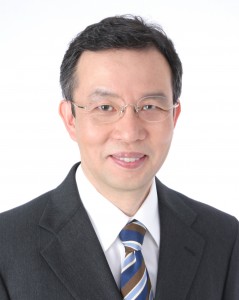Keiichiro Ogawa is a professor of chemistry at the Graduate School of Arts and Sciences, University of Tokyo, Japan. His research is aimed at the understanding and control of the dynamic behaviour of organic compounds and other molecular assemblies in crystals. Keiichiro was awarded the Crystallographic Society Japan Award in 1997 and recently a Chemical Society of Japan Contribution Award in 2007. He is a member of the CrystEngComm Advisory Board.
Why did you to become a scientist?
Having grown up in a family of three generations of scientists, I have wanted to be a scientist since boyhood. In particular, I was intrigued by science because it unravels the mysteries of the universe, and leads to technologies that contribute to our wellbeing.
What projects are you working on at the moment?
My group is working on solid-state reactions in organic crystals, particularly those related with color-changing phenomena, i.e., photochromism and thermochromism.
What do you think will be the next big breakthrough in your field?
Such a prediction is difficult but it will probably be the emergence of completely new methods for measuring these phenomena. If this happens it could provide totally a new insights into the world of matter, as brought about by the arrival of the analytical techniques in X-ray crystallography and NMR spectroscopy.
How do you think crystal engineering will develop in the next five years?
As methodologies for detection of minor products are refined, organic solid state reaction mechanisms should become better understood. This will give us much a more comprehensive picture of what happens in a sequence of solid-state reactions.
What is the most rewarding aspect of your work?
The excitement of presenting new findings and/or interpretations to an appreciative and expert audience!
Good people and good projects are the most essential components for successful scientific research. I’ve been fortunate in having an excellent research colleague, very good students and some challenging research topics.
What achievement are you most proud of?
I am particularly proud at having found that an apparent shortening of the central bond of stilbene-type molecules is caused by the torsional vibrations in crystals (K. Ogawa et al., JACS, 1992, 114, 1041). This finding led to the discovery of a more prominent molecular motion, i.e., pedal motion in crystals (J. Harada and K. Ogawa, Chem. Soc. Rev., 2009, 38, 2244.).
Young scientists must understand their principal research topic as deeply as possible, while being aware of the broader thrust of the field. The wider view can often provide insights into the subject you are most interested in.
What would you do if you weren’t a scientist?
My hobby is opera singing and my dream would be to be a professional singer, though I know I don’t have sufficient talent to start this career. Music can move one’s heart instantly, even within a second. Science can also do this, though not so quickly as in music. The important thing for me is that they both give joy.
What is your favourite place to be?
If I must live and work in one place, it would definitely be Tokyo. I have lived in Tokyo since my birth and I find it a vibrant, safe, and beautiful city. I like to visit other places, particularly in foreign countries, but I always enjoy returning home.
More about Keiichiro on his webpage at the University of Tokyo.
Read some of Keiichiro’s research in the following CrystEngComm articles:
Crystalline-state conformational change of β-nitrostyrenes and its freezing at low temperature
Jun Harada, Mayuko Harakawa and Keiichiro Ogawa
CrystEngComm, 2009, 11, 638-642 DOI: 10.1039/B815869J
Single crystal cis–trans photoisomerizations of 2-(9-anthrylmethylene)-1-indanones
Jun Harada, Mayuko Harakawa, Shingo Sugiyama and Keiichiro Ogawa
CrystEngComm, 2009, 11, 1235-1239 DOI: 10.1039/B821900A
Conformational change of all-trans-1,6-diphenyl-1,3,5-hexatriene in two crystalline forms
Jun Harada, Mayuko Harakawa and Keiichiro Ogawa
CrystEngComm, 2008, 10, 1777-1781 DOI: 10.1039/B811220G











